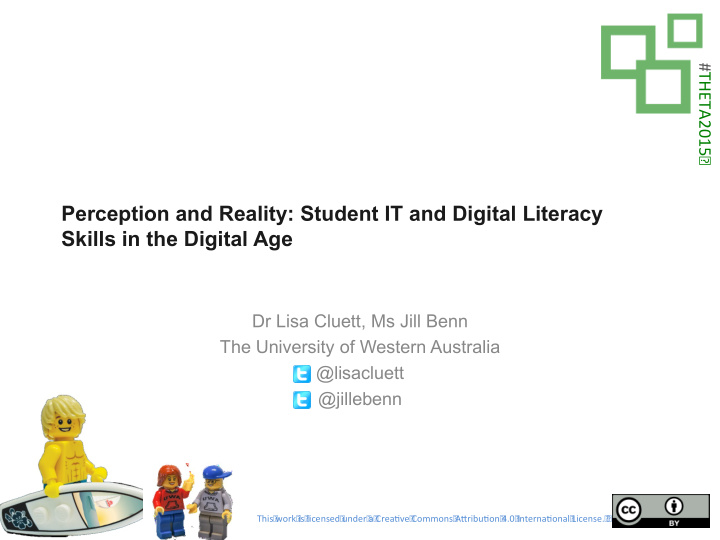



#THETA2015� Perception and Reality: Student IT and Digital Literacy Skills in the Digital Age Dr Lisa Cluett, Ms Jill Benn The University of Western Australia @lisacluett @jillebenn This� work� is� licensed� under� a� Crea ve� Commons� A ribu on� 4.0� Interna onal� License.� � The University of Western Australia
The University of Western Australia • University enrols more than 25,000 students, in eight faculties • 78.8% of the State's school-leavers with an ATAR of 95+ and 71.4% of those with an ATAR of 90+ • 88 th on the Academic Ranking of World Universities • Celebrated UWA Centenary in 2013
Overview 1. From computer training to digital citizenship 2. What do our stakeholders want, need and expect? 3. Making things happen “Our priority is to lead and inspire the development, “There is no activity more central to our University than Education ” delivery and support of a world-class student experience throughout UWA” UWA Vice-Chancellor UWA Deputy Vice-Chancellor (Education) Strategic Goals 2014-17
Literacies in the literature* Visual 1960’s Technological Computer Information Digital Literacies 2010’s and citizenship Literacy today depends on understanding the multiple media that make up our high-tech reality and developing the skills to use them effectively Jones-Kavalier and Flannigan (2006) *Source: Doug Belshaw's thesis -What is 'digital literacy'? A Pragmatic investigation
Phases of change ‘Middle’ phase • University required • High expectations jump in skills • ‘competence vs • Growth in student • Focus on technical confidence’ skills skills • Variable skill set • Assumed ‘level playing field’ ‘Current’ ‘Early’ phase phase
History
Phases of change ‘Middle’ phase • University required • High expectations jump in skills • ‘competence vs • Growth in student • Focus on technical confidence’ skills skills • Variable skill set • Assumed ‘level playing field’ ‘Current’ ‘Early’ phase phase
Reused here with permission
Trends and emerging issues Source: http://www.jisc.ac.uk/guides/enhancing-the-digital-student-experience
Trends and emerging issues Source: http://www.jisc.ac.uk/guides/developing-students-digital-literacy
Trends and emerging issues Source: https://www.infoxchange.net.au/welcome-digital-inclusion-program/go-digi-national-digital-literacy-program
Trends and emerging issues Source: https://www.microsoft.com/about/corporatecitizenship/citizenship/giving/programs/up/digitalliteracy/default.mspx
Trends and emerging issues https://hr.deakin.edu.au/plsdocs/hr/WK8127$APP.draw_attachments?P_VACANCY_REF_NO=150140&P_CALLER_URL=WK8127ZZDOLLA RZZAPP.QueryListZZQMARKZZZ_VACANCY_CAT=GZZAMPZZZ_ORDER_BY=1
Trends and emerging issues Source: http://www.library.illinois.edu/diglit/tutorial/
Part 2 - What do our stakeholders want, need and expect? • Overview of what we gather and why
TechNODE bulletin 2006-2015 • Annual survey of first year students’ access to, experiences with and expectations of emerging technologies and social media at University (UWA) • Findings are used in university decision making • Highlights gaps between myth and reality
Library Student IT Help Service
Digital Literacy Skills Survey • Inquiries presenting at library information desks • Identify what digital skills were important to students • Survey results – Software training (73.4%) – General skills (20.9%) – Computer basics (5.5%)
Part 3 – Making Things Happen
Digital Skills at UWA • Emphasis on online self-help • Embed support in current initiatives • Pop-up and Drop-in workshops • UWA Digital Literacy Framework
UWA Digital Literacy Framework
Communication and Research Skills (CARS) http://www.student.uwa.edu.au/learning/resources/cars
Academic Conduct Essentials (ACE) http://www.student.uwa.edu.au/learning/resources/ace
Future Ideas and Challenges • Developing existing tools for digital skills delivery • Build IT and Use IT development • Increasing support for particular student cohorts • Tools constantly evolving • Resourcing constraints and doing more with less
Questions
Recommend
More recommend